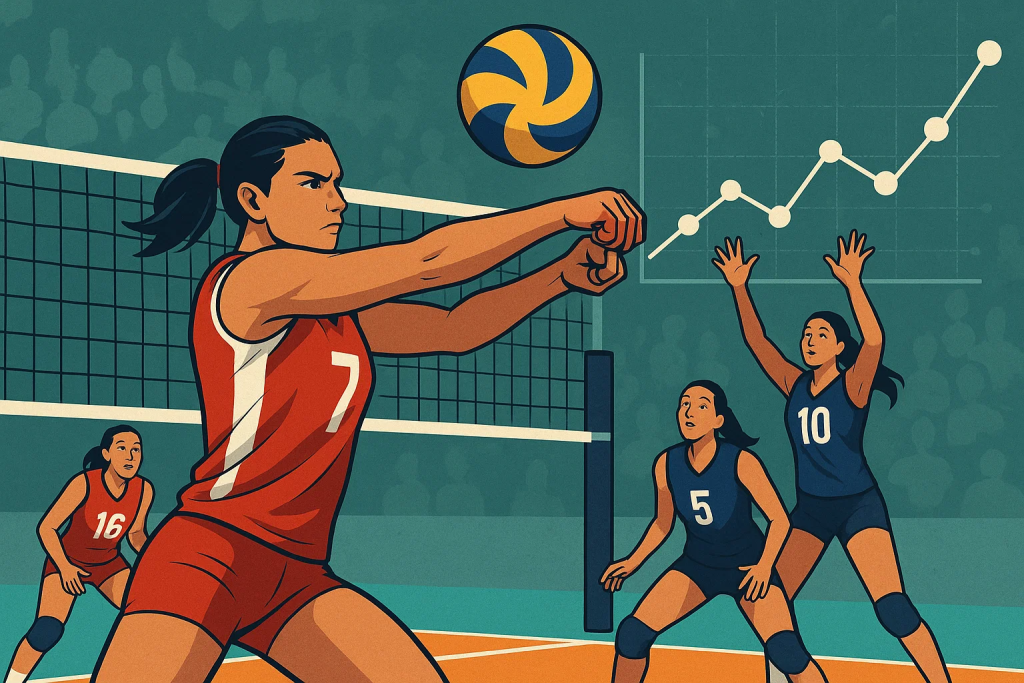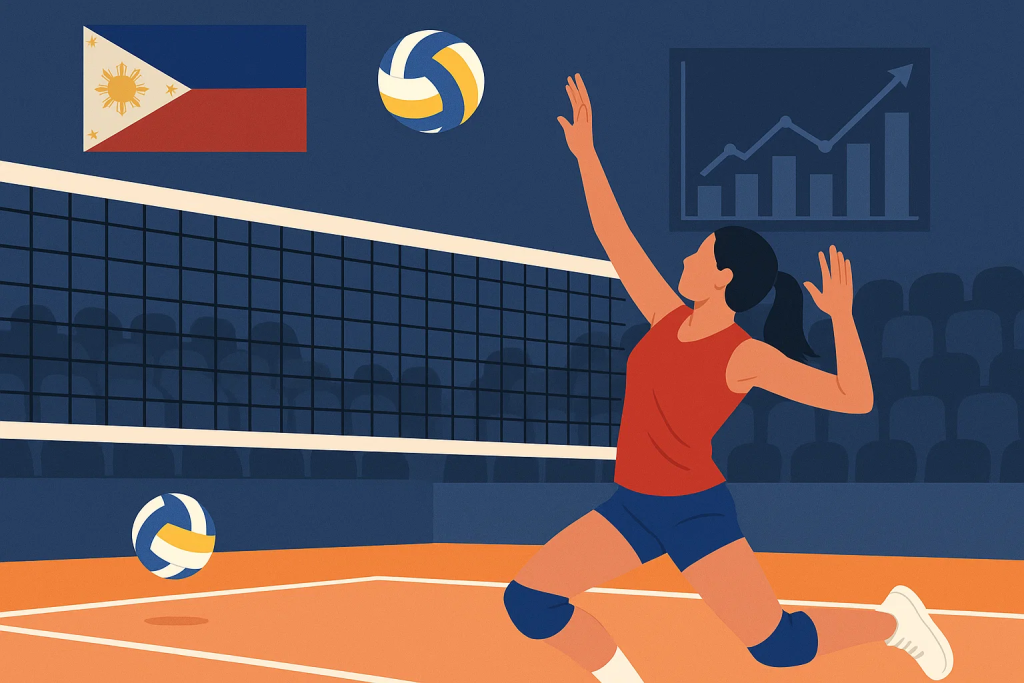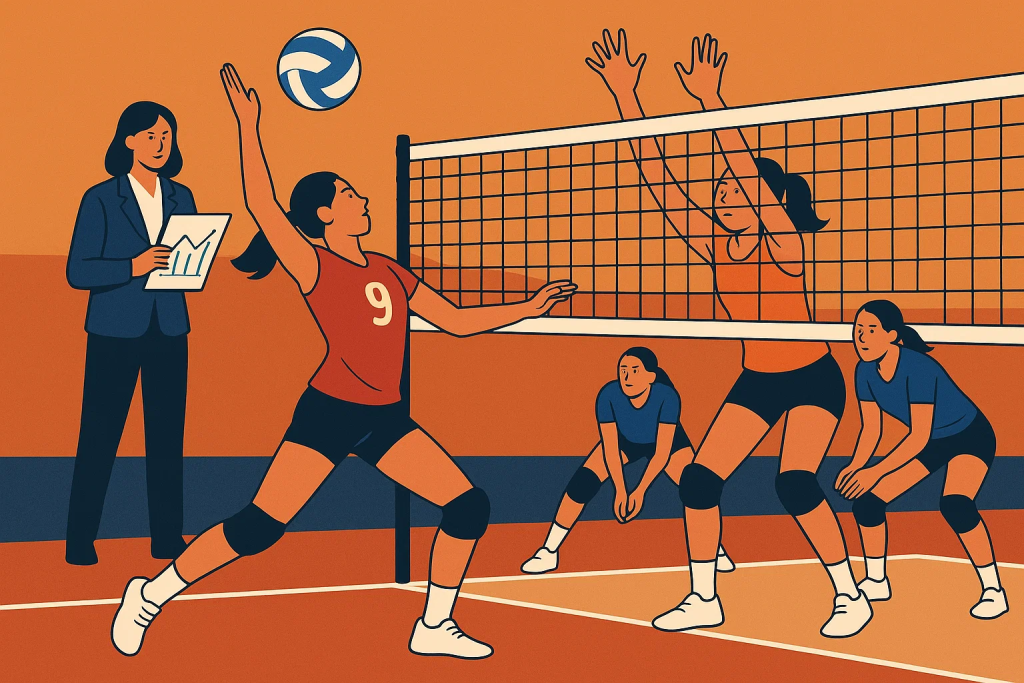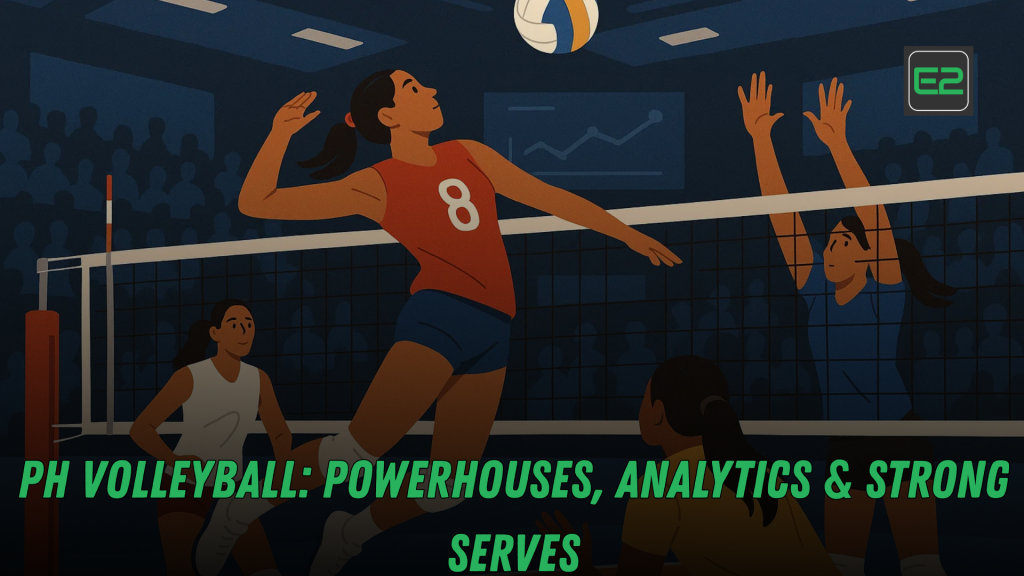Table of Contents
TL;DR
- Powerhouses in Philippine volleyball are built on systems, not just stars: recruiting pipelines, skills academies, and aligned strength & conditioning.
- Analytics turns highlight moments into repeatable wins: track side-out%, first-ball side-out, rotation efficiency, serve-receive ratings, and transition kill% to pinpoint your edge.
- Strong serves win modern matches: learn jump float, hybrid, and topspin mechanics, target seams/weak zones, and use risk–reward math to choose the right pressure level in each rotation.
- Inside: a drill library, scouting workbook, sample dashboards, and a 90-day adoption plan for clubs, schools, and provincial teams.

Keyword Map (for SEO)
- Primary: Philippine volleyball, PH volleyball powerhouses, volleyball analytics, strong serves, serve receive, rotation efficiency
- Supporting: volleyball drills, scouting report template, side-out percentage, jump float serve, topspin serve, volleyball KPIs, setter distribution, serve targets
- Search intent mix: informational (how to improve), transactional (join training, book clinic), navigational (find league/club)
- On-page tips: Use H2/H3 hierarchy, bullets, short paragraphs, schema FAQPage, and descriptive alt text for images (e.g., “jump-float toss at eye level”).
1) The PH Volleyball Landscape in 2025: What’s Driving the Surge
Philippine volleyball has matured from campus-centric rivalries into a multi-tier ecosystem: grassroots clinics, school leagues, university powerhouses, club/pro scenes, and national teams—across indoor and beach formats. Three forces power this rise:
- Youth development & camps: Skills academies and weekend clinics standardize footwork, hand-contact, and serve-receive fundamentals earlier.
- Sports science: More teams use wearables, video tagging, and load monitoring to keep athletes healthy and sharpen decision-making.
- Content flywheel: Social video (shorts/reels/TikTok) turns rallies into stories, fueling fan growth, sponsors, and a better talent funnel.
Takeaway: Success scales when programs treat volleyball as a system—recruiting → skill acquisition → video & data → S&C → recovery → fan engagement.
2) Anatomy of a Volleyball “Powerhouse” in Philippine Volleyball
Powerhouses aren’t just teams that win; they’re organizations that can stay near the top across multiple seasons. Here’s the blueprint.
2.1 Talent Pipeline
- Regional scouts & clinics: Map feeder schools and host regional ID camps each off-season.
- Skill rubric (14U–U18): Passing angles, platform stability, approach timing, shoulder external rotation, serve types (standing → float → jump float → hybrid).
- Holistic profiling: Movement screen (ankle dorsiflexion, hip IR/ER), shoulder ROM, landing audit (two-leg vs. single-leg bias), and game IQ quiz.
2.2 Staff Model
- Head coach = system architect. Defines game model (tempo, serve pressure profile, block scheme).
- Assistant/analyst. Handles video tagging, KPI dashboards, scouting, and rotation strategy.
- S&C + AT. Strength coach and athletic trainer integrate load management, jump count, and shoulder care.
- Player-leaders. Captains own bench cues, in-match communication, and huddle resets.
2.3 Cultural Moats
- Shared language: Everyone knows what “SO% > 62 in Rot 1” means and what to do to fix it.
- Feedback architecture: 10-minute post-match review with two clips per athlete (one strength, one growth point).
- Consistency > magic: Keep the same serve zones, cue words, and scouting process across levels.
3) Analytics 101: Volleyball KPIs That Actually Move the Score
Forget vanity stats. These are your must-track metrics with definitions and coaching implications.
3.1 Side-Out Engine
- Side-Out% (SO%): Points you win on the exact rally after the opponent serves.
- Why it matters: Champions keep SO% ≥ 60–65% versus quality opponents; below ~58% and you chase all night.
- First-Ball Side-Out (FBSO%): Side-out on the first attack of the rally.
- Coaching use: Shows how clean your pass → set → swing pipeline is.
3.2 Rotation Efficiency
- Track Rotations 1–6: SO%, point-scored% while serving, net differential.
- Coaching use: Swap opposite/outside in serve order to protect weak passing rotations; place best server to punish opponent’s weakest passer.
3.3 Serve–Receive Ratings
- Pass rating (e.g., 0–3 scale): 3 = in-system (setter’s head), 2 = workable, 1 = off-net, 0 = ace.
- Use: Individual passer report + team heatmap. Target the lowest AVG and the highest variance.
3.4 Transition Kill%
- TRN Kill%: Kills after digging the opponent’s attack.
- Use: Measures your ability to turn defense into points. Great serving elevates TRN Kill% by forcing more predictable swings.
3.5 Setter Distribution & Efficiency
- Set map: % sets to OH1/OH2/OPP/MB/pipe;
- Outcome by lane: Kill%, error%, block%.
- Use: Spot over-reliance and teach “load-balance under pressure.”
3.6 Error Economy
- Serve errors per set and attack errors per set;
- Net penalty & overlap errors (free points).
- Use: Tune risk to match state (more below).
Pro tip: Start with SO%, FBSO%, rotation tables, pass rating averages, and serve errors. Add depth (TRN Kill%, set maps) as your video-tagging improves.
4) The Science of Volleyball Strong Serves: Mechanics, Aiming & Match Math
Serving is the only closed-skill you fully control. It dictates who gets to be in system—you or them.
4.1 Biomechanics Cheat Sheet
- Jump Float
- Toss: Chest/eye level, a touch forward.
- Contact: Flat palm, no wrist snap, high reach, minimal spin.
- Cue: “Rise, freeze, laser.”
- Topspin Jump
- Toss: Slightly higher and further forward.
- Contact: Pronated wrist snap; drive through the panel.
- Cue: “Up, whip, down.”
- Hybrid (top-float or float-top)
- Same approach as jump float but vary wrist to add late dip.
- Cue: “Same toss, surprise finish.”
Common faults & fixes
- Toss too high → chaotic timing → keep toss within 15–25 cm of consistent apex.
- Drifting approach → “Nail the spot where you’ll land first,” then toss into that lane.
- Low elbow → shoulder stress → high elbow–high hand.
4.2 Targeting Strategy (Zones & Seams)
- Zones: Backcourt 1–6–5 and short 2/3/4; seam between passers creates hesitation.
- Scouting overlay:
- If OH2 is the weakest passer (2.1 AVG), pin them with flat float to seam 5/6.
- If the setter is front-row, serve short at 2 to move them off the net and kill the quick.
- Against elite passers, use late-moving jump float to seam + occasional deep 1 to line to stress footwork.
4.3 Risk–Reward Math (“Green–Yellow–Red”)
- Green: Serve in with pace to low-risk zones; target seams; < 1 miss per 6 serves.
- Yellow (when ahead by 3–5): Add velocity/angle to the weaker passer; accept 1 miss per 4–5 if aces or out-of-system balls rise.
- Red (down 22–24): Choose your highest in-rate serve that still disrupts. Many sets flip on a high, deep float to zone 1.
Serve Value (SV) quick calc
SV = (Opp OOS% × your TRN Kill%) − (your miss% × penalty value)
Adjust penalty value higher late in sets; let SV drive how aggressive you get.
5) Serve & Pass Volleyball Drill Library (with measurable goals)
1) 3-Cone Accuracy (10 min)
- Cones in deep 1, deep 6, short 2.
- Goal: 8/10 in-rate; 6+ direct to cone ring.
2) Seam Harassment (12 min)
- Two passers; coach calls “seam left/right” mid-toss.
- Goal: Force mis-read or 2-pass; track pass AVG per passer.
3) Short-Deep Ladder (10 min)
- Alternate short 2 → deep 1; then short 3 → deep 5.
- Goal: Maintain ≥ 80% in-rate while varying depth.
4) Red-Zone Pressure (8 min)
- Scoreboard set to 23–23; each miss deducts 1.
- Goal: Practice clutch routines.
5) Pass-to-Kill (15 min)
- Serve → pass → coach toss → swing to zone markers.
- Goal: FBSO% ≥ 65% with pass AVG ≥ 2.3.
6) Chaos Transition (12 min)
- Coach tips or rolls after serve; team must free-ball then run quick.
- Goal: TRN Kill% ≥ 40% in the block.
6) Volleyball Scouting: From YouTube Clips to Rotation-by-Rotation Plans
Step 1: Collect film from at least two matches versus comparable opponents.
Step 2: Tag essentials: server name, target zone, passer, pass rating, setter location, first-ball direction, kill/error/block.
Step 3: Build the scouting grid (example)
| Opp Rotation | Setter Row | Weak Passer | Favorite First Ball | Serve Target | Block Call |
|---|---|---|---|---|---|
| R1 | Front | OH2 (2.0 AVG) | Quick A / Pipe | Short 2 / Seam 5-6 | Read quick, shade pipe |
| R2 | Back | L (2.2 AVG) | OH1 Line | Deep 1 | Funnel to MB hands |
| R3 | Front | OPP (1.9 AVG) | Back-set | Deep 5 / at OPP | Commit if setter jump-sets |
Step 4: Print a one-pager for captains with three priorities: (1) serve zones, (2) first-ball tendencies, (3) emergency cue (e.g., “If setter front: short 2 now”).
7) Volleyball Rotation Surgery: Fix Your Worst Two Rotations First
- Identify the two lowest SO% rotations.
- Try one change at a time:
- Switch the libero to a different lane.
- Flip OHs for one rotation.
- Stagger the approach lane for your best quick.
- Re-measure after two matches; keep what moves SO% ≥ +5.
8) Volleyball Strength, Mobility & Shoulder Care (Server’s Edition)
- Daily 12-minute pre-court
- T-spine openers, band ER/IR, scap push-ups, isometric Ys/Ts.
- Landing mechanics
- Soft knees/hips, quiet feet, avoid valgus collapse.
- Load management
- Track jump count and serve count; cap high-intensity serves on back-to-back days.
- Post-serve reset
- 30–45 s of light scap retractions and breathing to “down-regulate.”

9) The Volleyball Fan’s Guide: How to “Read” a PH Volleyball Match
- Serve pressure: Notice when a team targets the same passer 3–4 times—expect a time-out or sub.
- Setter tempo: Quick/pipe frequency reveals in-system health.
- Rotation tells: When a team stalls at Rot 4, watch for libero swaps or a serving sub to break momentum.
- Body-language momentum: Fast huddles after errors and decisive ball-chasing often predict mini-runs.
10) Sample Dashboards & Stat Templates
Team Dashboard (one page)
- Top row: SO% by rotation (bar), FBSO%, serve errors, aces, TRN Kill%.
- Middle: Pass AVG per player (table); heatmap of serve targets.
- Bottom: Setter distribution pie + kill% per lane.
Player Card (per match)
- Serve: in-rate, aces, targets hit, clutch serves (23–23+).
- Pass: attempts, AVG, forced overpasses.
- Attack: attempts, kill%, error%, block%.
- Defense: digs, dig-to-kill%.
Export tip: Use consistent column names (Rotation, ServeZone, Passer, PassRating, Outcome) to automate charts.
11) 90-Day Analytics Adoption Plan (Club/School)
Days 1–14: Foundation
- Pick 5 KPIs: SO%, FBSO%, pass AVG, serve errors, rotation efficiency.
- Train managers to tag film; build a simple Google Sheet + color rules.
Days 15–45: First Upgrades
- Add serve target data and passer IDs.
- Pilot two serve protocols (accuracy ladder, red-zone pressure).
- Goal: +4 SO% in one weak rotation.
Days 46–75: Scouting Standard
- Build opponent grids; run two A/B strategies in scrimmages.
- Start TRN Kill% tagging; test block calls.
Days 76–90: Systemize
- Publish one-page reports post-match; educate fans/parents via a digest (“What moved the needle”).
- Lock your season templates and playbook.
12) Content & Community: Turning Data into Momentum
- Match threads: Post rotation charts and serve maps next day—teach fans the language of the team.
- Clinic days: Offer “serve lab” sessions; sell out slots with a “hit the cone” challenge.
- Sponsor alignment: Data-driven stories (“+6 SO% since July”) are gold for local partners.
- Creator collabs: Mic’d-up serve routines, setter POV cams, and slow-mo topspin breakdowns.
13) Troubleshooting: If Your Serve Plan Isn’t Working
- In-rate < 80%? Lower toss height, aim center-back seam, switch to jump float for two rotations.
- Great serve, weak pass-to-kill? Your defense is generating OOS balls, but transition spacing is off; add dig-set lanes and “free-ball to quick” automations.
- Rotation stuck? Substitute a serving specialist to attack the identified passer; or move best passer into that lane for two points.
- Setter over-feeding one hitter? In huddle, call a 2-point distribution rule (max two consecutive to same lane unless 1v0).
14) A Match-Day Blueprint (Coach’s Checklist)
T-90 min: Mobility, activation, serve ladder (8 minutes), rhythm tosses.
T-60: Serve-receive patterns: call zones aloud; quick FBSO walk-through.
T-30: Scout reminder—who to target, seams, and the first ball we want.
During sets:
- If serve run stalls at 1 → change serve type or location; never repeat miss short.
- If pass AVG dips < 2.1 → bring libero across or swap lanes; simplify first-ball to your highest-percentage quick/out.
Timeout phrasing (10 seconds): “Green: in with pace to seam 5/6. Yellow when up 3. Red at 23–23 = deep 1, no gifts.”
15) Why Powerhouses Win Close Sets
- Stable routines under pressure (everyone breathes, everyone repeats).
- Rotation clarity (no “where do I stand?” at 24–24).
- Serve personalities (one fearless topspin cannon, one seam surgeon, one short-ball artist).
- Data humility (adjust when the map is wrong, not after the match).
Strong Call-to-Action
Ready to level up your program’s serving and analytics?
Comment with your level (HS, university, club), your biggest pain point (e.g., Rot 1 SO% = 52, serve errors = 10), and how many training slots you have weekly. I’ll reply with a custom 7-day micro-plan (two serve drills, a rotation tweak, and a one-page dashboard template) you can deploy immediately. Share this guide with your staff and captains—turn insight into side-outs starting next practice.
Philippine volleyball is entering a systems era: powerhouses are built on talent pipelines, data-savvy staffs, S&C, and consistent culture. The guide pinpoints analytics that move the score—Side-Out% (goal 60–65%), First-Ball Side-Out, rotation efficiency, pass ratings (0–3), transition kill%, setter distribution, and error economy—to diagnose weak rotations and sharpen serve–receive.
Serving is framed as the controllable separator: master jump float, hybrid, and topspin; attack seams and priority zones (deep 1/6, short 2); and scale aggression with a Green–Yellow–Red risk model tied to scoreboard context. Practice frameworks include measurable serve/pass drills, scouting grids by rotation, and “rotation surgery” to raise the two worst rotations first.

Support pillars cover shoulder care, landing mechanics, load tracking, and simple dashboards (team + player cards) fed by smartphone tagging. A 90-day adoption plan phases KPIs, scouting, and reporting. Bottom line: measure what matters, apply purposeful serve pressure, and convert analytics into repeatable side-outs.
FAQs
1) What side-out percentage should a competitive PH program aim for?
Most competitive teams target 60–65% SO% against comparable opposition. If you’re below ~58%, fix serve-receive in your two weakest rotations and simplify your first-ball call (e.g., quick A or high out to your best hitter).
2) Which serve gives the best “disruption per risk” ratio?
For many teams, the jump float (or a firm standing float) offers the best blend of in-rate and movement, especially to seams and deep 1. Once in-rate stays ≥ 85%, layer hybrid and topspin on your serving specialists.
3) How do I start analytics without expensive software?
Tag with a smartphone: columns for Rotation, Server, Target Zone, Passer, Pass Rating (0–3), First-ball Outcome. Use simple conditional colors to surface weak rotations and passers. Upgrade later to dedicated tagging apps.
4) What’s a quick fix for a bad rotation?
Move your best passer into the problem lane for two points, bring in a serving sub to hit that opponent’s weak passer, and choose a high-probability first-ball (your highest FBSO pattern). Re-measure after two matches.
5) My servers ace in warmups but miss in sets—why?
Warmups don’t simulate pressure and targets. Add red-zone pressure drills (23–23 scenarios), lower your toss height for consistency, and build a three-word routine (e.g., “breathe–aim–freeze”). Track clutch in-rate separately to reward the right habits.
